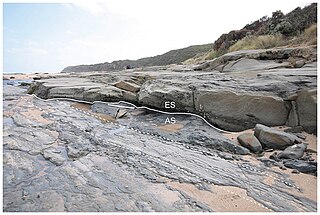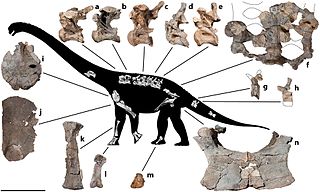
Fukuiraptor was a medium-sized megaraptoran theropod dinosaur of the Early Cretaceous epoch that lived in what is now Japan. Fukuiraptor is known from the Kitadani Formation and possibly also the Sebayashi Formation.

Deltadromeus is a genus of theropod dinosaur from Northern Africa. It had long, unusually slender hind limbs for its size, suggesting that it was a swift runner. The skull is not known. One fossil specimen of a single species has been described, found in the Kem Kem Beds, which date to the mid-Cretaceous Period, about 95 million years ago. It may be a junior synonym of the contemporary Bahariasaurus. The classification of Deltadromeus has been in flux since its original description. In 2016, a South American theropod known as Gualicho shinyae was found to possess many similarities with Deltadromeus. Depending on the phylogenetic position of Gualicho, Deltadromeus may have been a neovenatorid carnosaur, a tyrannosauroid, or a basal coelurosaur if its close relation to Gualicho is legitimate. Other studies have considered it a ceratosaurian, more specifically a member of the family Noasauridae.

Megaraptor is a genus of large theropod dinosaur that lived in the ages of the Late Cretaceous. Its fossils have been discovered in the Patagonian Portezuelo Formation of Argentina, South America. Initially thought to have been a giant dromaeosaur-like coelurosaur, it was classified as a neovenatorid allosauroid in previous phylogenies, but more recent phylogeny and discoveries of related megaraptoran genera has placed it as either a basal tyrannosauroid or a basal coelurosaur with some studies still considering it a neovenatorid.

Austrosaurus was an extinct genus of titanosaurian sauropod dinosaur from the Allaru Formation, from the early Cretaceous of Central-Western Queensland in Australia.

Rapator is a genus of theropod dinosaur from the Griman Creek Formation of New South Wales, Australia, dating to the Albian-Cenomanian ages of the Cretaceous period, 105-96 million years ago. It contains only the type species, Rapator ornitholestoides, which was originally named by Friedrich von Huene in 1932.

Orkoraptor is a genus of medium-sized megaraptoran theropod dinosaur from the late Cretaceous Period of Argentina. It is known from incomplete fossil remains including parts of the skull, teeth, tail vertebrae, and a partial tibia. The specialized teeth resemble those of some maniraptoriform theropods, namely the deinonychosaurs and compsognathids. This and other anatomical features led the authors who described it to suggest that it was a maniraptoran coelurosaur. However, subsequent studies found it to be a megaraptoran. Found in the Cerro Fortaleza Formation of Southern Patagonia, it is one of the southernmost carnivorous dinosaurs known from South America.

Aerosteon is a genus of megaraptoran dinosaur from the Late Cretaceous period of Argentina. Its remains were discovered in 1996 in the Anacleto Formation, which is from the late Campanian. The type and only known species is A. riocoloradensis. Its specific name indicates that its remains were found 1 km north of the Río Colorado, in Mendoza Province, Argentina.

The Eumeralla Formation is a geological formation in Victoria, Australia whose strata date back to the Early Cretaceous. It is Aptian to Albian in age. Dinosaur remains are among the fossils that have been recovered from the formation, particularly from the Dinosaur Cove locality.

Wintonotitan is a genus of titanosauriform dinosaur from late Albian -age Winton Formation of Australia. It is known from partial postcranial remains.

Diamantinasaurus is a genus of titanosaurian sauropod from Australia that lived during the early Late Cretaceous, about 94 million years ago. The type species of the genus is D. matildae, first described and named in 2009 by Scott Hocknull and colleagues based on fossil finds in the Winton Formation. Meaning "Diamantina lizard", the name is derived from the location of the nearby Diamantina River and the Greek word sauros, "lizard". The specific epithet is from the Australian song Waltzing Matilda, also the locality of the holotype and paratype. The known skeleton includes most of the forelimb, shoulder girdle, pelvis, hindlimb and ribs of the holotype, and one shoulder bone, a radius and some vertebrae of the paratype.

Neovenatoridae is a proposed clade of carcharodontosaurian dinosaurs uniting some primitive members of the group such as Neovenator with the Megaraptora, a group of theropods with controversial affinities. Other studies recover megaraptorans as basal coelurosaurs unrelated to carcharodontosaurs. Other theropods with uncertain affinities such as Gualicho, Chilantaisaurus and Deltadromeus are also sometimes included.

Megaraptora is a clade of carnivorous tetanuran theropod dinosaurs with controversial relations to other theropods. Its derived members, the Megaraptoridae are noted for their large hand claws and robust forelimbs, which are usually reduced in size in other large theropods.

Siats (/see-ats/) is an extinct genus of large theropod dinosaur known from the Late Cretaceous Cedar Mountain Formation of Utah, United States. It contains a single species, Siats meekerorum. It was initially classified as a megaraptoran, a clade of large theropods with very controversial relationships. Siats may be a neovenatorid allosauroid, a coelurosaur of uncertain phylogenetic position, or a tyrannosauroid.

Australian Age of Dinosaurs Ltd (AAOD) is a nonprofit organization located in Winton, Queensland and was founded by David Elliott and Judy Elliott in 2002. The organization’s activities include operation of the Australian Age of Dinosaurs Museum of Natural History, which holds annual dinosaur digs in the Winton Formation of Western Queensland and oversees the year-round operation of Australia's most productive dinosaur fossil preparation laboratory. Since 2005, the AAOD Museum has accumulated the largest collection of Australian dinosaur fossils in the world and holds the holotype specimens of Diamantinasaurus matildae ("Matilda"), Savannasaurus elliottorum ("Wade"), Australovenator wintonensis ("Banjo"), Australia's most complete theropod skeleton, Ferrodraco lentoni, the first pterosaur to be named from the Winton Formation and Confractosuchus sauroktonos. The museum is open to the public daily from April to October and is open six days from November to March. The site of the museum was designated a dark-sky preserve, the first International Dark-Sky Sanctuary in Australia, in 2019.

Murusraptor is a genus of carnivorous megaraptoran theropod dinosaur from the Sierra Barrosa Formation, part of the Neuquén Group of Patagonia, in Argentina, South America. It is known from a single specimen that consists of a partial skull, ribs, partial pelvis, leg and other assorted skeletal elements.

Savannasaurus is a genus of titanosaurian sauropod dinosaur from the Late Cretaceous Winton Formation of Queensland, Australia. It contains one species, Savannasaurus elliottorum, named in 2016 by Stephen Poropat and colleagues. The holotype and only known specimen, originally nicknamed "Wade", is the most complete specimen of an Australian sauropod, and is held at the Australian Age of Dinosaurs museum. Dinosaurs known from contemporary rocks include its close relative Diamantinasaurus and the theropod Australovenator; associated teeth suggest that Australovenator may have fed on the holotype specimen.

Tratayenia is an extinct genus of megaraptoran theropod dinosaurs known from remains found in the Santonian-age Bajo de la Carpa Formation of Argentina. The type and only species, Tratayenia rosalesi, was described in March 2018.

Phuwiangvenator is an extinct genus of megaraptoran theropod that lived during the Early Cretaceous period in what is now Thailand. It contains only the type species, P. yaemniyomi. The generic name of Phuwiangvenator comes from the Phu Wiang mountains, where the holotype was discovered, and the Latin word "venator" meaning hunter. The specific name, "yaemniyomi", is in honor of Sudham Yaemniyom, who was a historical paleontologist from Thailand and the first person to discover fossils there.

Maip is a genus of large megaraptorid theropod dinosaur from the Late Cretaceous (Maastrichtian) Chorrillo Formation of Santa Cruz, Argentina. The genus contains a single species, M. macrothorax, known from an incomplete, disarticulated skeleton. Maip may represent the largest megaraptorid known from South America, and possibly the world.







































